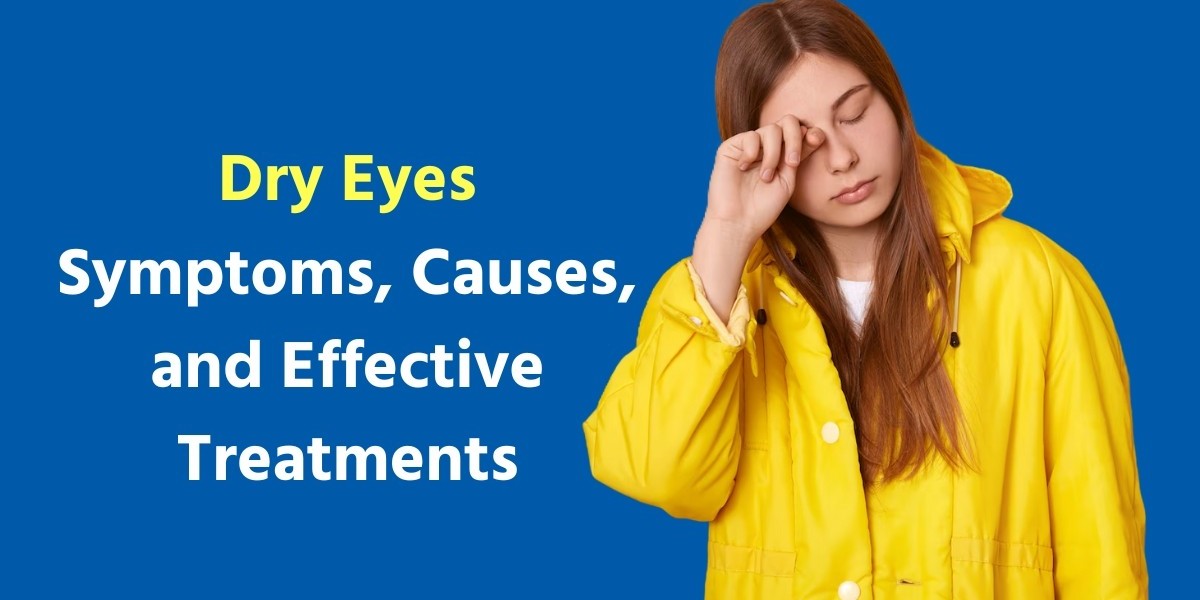Dry eyes are a common yet often uncomfortable condition that occurs when your tears fail to provide adequate lubrication for your eyes. Whether due to environmental factors, aging, or underlying health conditions, dry eyes can lead to irritation, redness, and even blurred vision. Understanding the dry eyes symptoms and treatment options can help you manage this condition effectively. If symptoms persist, visiting the best eye hospital in Hyderabad for professional care is highly recommended.
What Are Dry Eyes?
Dry eye syndrome (DES), also known as keratoconjunctivitis sicca, happens when your eyes don’t produce enough tears or when the tears evaporate too quickly. Tears are essential for maintaining eye health, providing moisture, clearing away debris, and protecting against infections. When tear production or quality is compromised, it can lead to chronic dryness and discomfort.
Common Symptoms of Dry Eyes
Recognizing the dry eyes symptoms and treatment needs early can prevent complications. Some of the most frequent signs include:
- Persistent dryness or a gritty sensation, as if something is stuck in the eye
- Redness and irritation, often worsening with screen time or windy conditions
- Burning or stinging that doesn’t go away with blinking
- Excessive tearing (paradoxical, as dryness can trigger reflex watering)
- Blurred vision, especially after prolonged focus
- Light sensitivity, making it uncomfortable to be in bright environments
- Difficulty wearing contact lenses due to discomfort
If these symptoms persist, it’s advisable to consult an ophthalmologist at the best eye hospital in Hyderabad for a thorough evaluation.
What Causes Dry Eyes?
Several factors contribute to dry eye syndrome, ranging from lifestyle habits to medical conditions. Understanding the root cause helps in selecting the right dry eyes symptoms and treatment approach.
- Decreased Tear Production: - Aging is a leading cause, as tear production naturally declines with age. Additionally, medical conditions such as diabetes, rheumatoid arthritis, and thyroid disorders can reduce tear secretion.
- Increased Tear Evaporation: - Environmental factors like dry air, wind, smoke, or prolonged screen use (reduced blinking) can accelerate tear evaporation. Meibomian gland dysfunction (MGD), where eyelid glands don’t produce enough oil to stabilize tears, is another major contributor.
- Hormonal Changes: - Women are more prone to dry eyes due to hormonal fluctuations during pregnancy, menopause, or while using oral contraceptives.
- Medications: - Certain drugs, including antihistamines, decongestants, blood pressure medications, and antidepressants, can reduce tear production.
- Contact Lens Wear: - Long-term use of contact lenses can disrupt the tear film, leading to dryness and irritation.
- Underlying Eye Conditions: - Blepharitis (eyelid inflammation), allergies, or previous eye surgeries (like LASIK) can also contribute to dry eyes.
Effective Treatments for Dry Eyes
Managing dry eyes involves a combination of lifestyle changes, medical treatments, and professional care. Here are some of the most effective dry eyes symptoms and treatment strategies:
- Artificial Tears and Lubricating Eye Drops: - Over-the-counter artificial tears provide temporary relief by supplementing natural tear production. For chronic cases, preservative-free options are recommended to avoid further irritation.
- Prescription Medications: - If standard eye drops aren’t effective, doctors may prescribe:
=> Cyclosporine (Restasis) or Lifitegrast (Xiidra) to reduce inflammation and boost tear production.
=> Steroid eye drops (short-term use) for severe inflammation. - Warm Compresses and Eyelid Hygiene: - For Meibomian gland dysfunction, applying a warm compress and gently massaging the eyelids can help unclog oil glands. Regular eyelid cleaning with a mild cleanser also prevents inflammation.
- Punctal Plugs: - In cases where tears drain too quickly, tiny silicone plugs can be inserted into tear ducts to retain moisture on the eye’s surface.
- Lifestyle Adjustments: -
=> Take frequent breaks during screen time (follow the 20-20-20 rule: every 20 minutes, look
20 feet away for 20 seconds).
=> Use a humidifier to add moisture to dry indoor air.
=> Wear wraparound sunglasses outdoors to shield eyes from wind and dust.
=> Stay hydrated and consume omega-3 fatty acids (found in fish, flaxseeds) to support tear
quality. - Advanced Medical Treatments: - For severe cases, procedures like intense pulsed light (IPL) therapy or autologous serum eye drops (made from the patient’s blood) may be recommended.
When to See a Specialist
While mild dry eyes can often be managed at home, persistent symptoms—such as severe pain, vision changes, or corneal damage—require professional attention. If you’re in Hyderabad, visiting the best eye hospital in Hyderabad ensures access to advanced diagnostics and personalized treatment plans.
Preventing Dry Eyes
Preventive measures can significantly reduce the risk of developing chronic dry eyes:
- Blink regularly, especially when using digital devices.
- Avoid direct exposure to fans, air conditioners, or heaters.
- Remove eye makeup thoroughly to prevent gland blockages.
- Get regular eye check-ups, particularly if you have underlying health conditions.
Final Thoughts
Dry eye syndrome is a manageable condition when addressed early. By recognizing the dry eyes symptoms and treatment options, you can take proactive steps to protect your vision and comfort. If over-the-counter remedies aren’t enough, seeking expert care at the best eye hospital in Hyderabad can provide long-term relief and prevent complications. Don’t ignore persistent dryness—your eyes deserve the best care!







